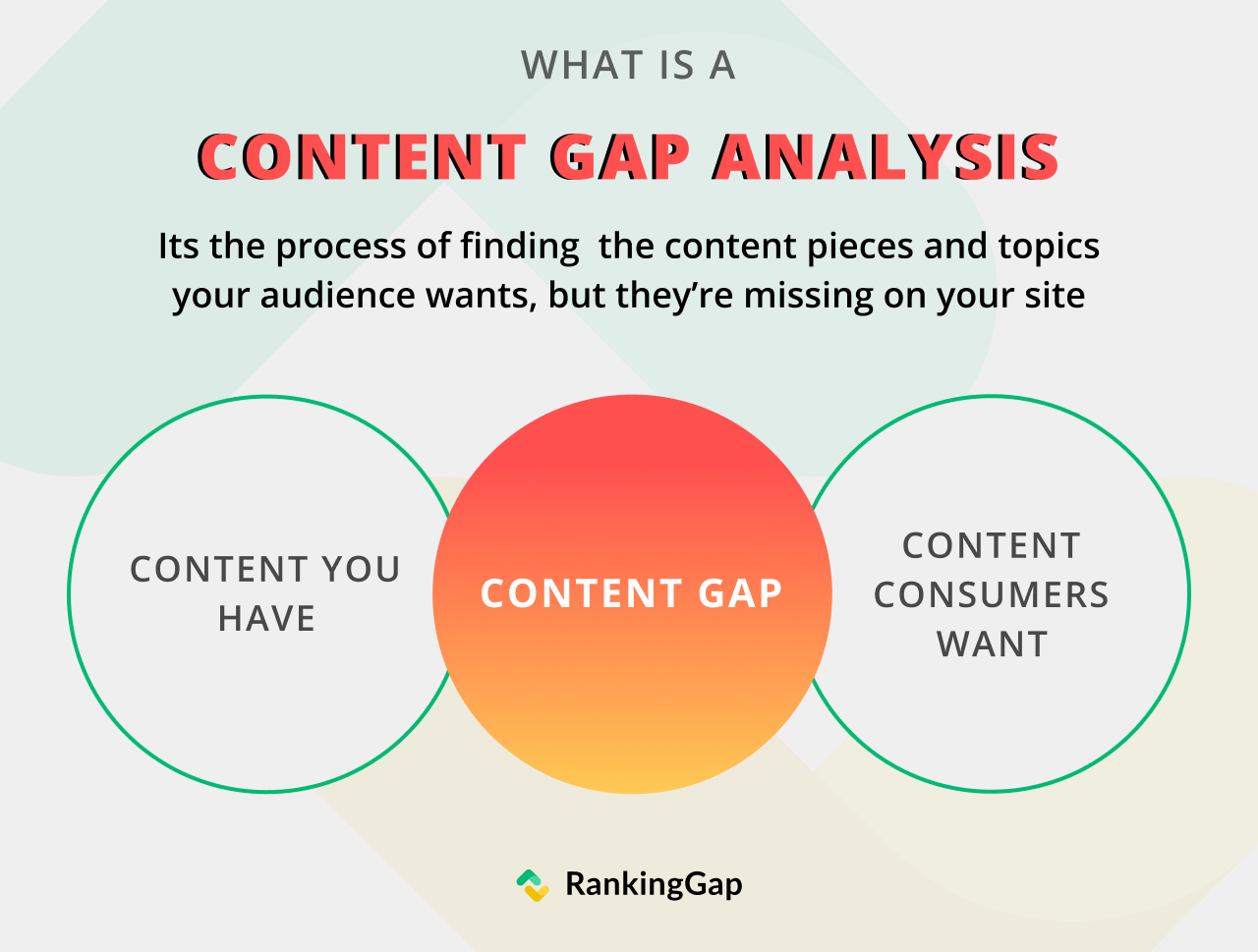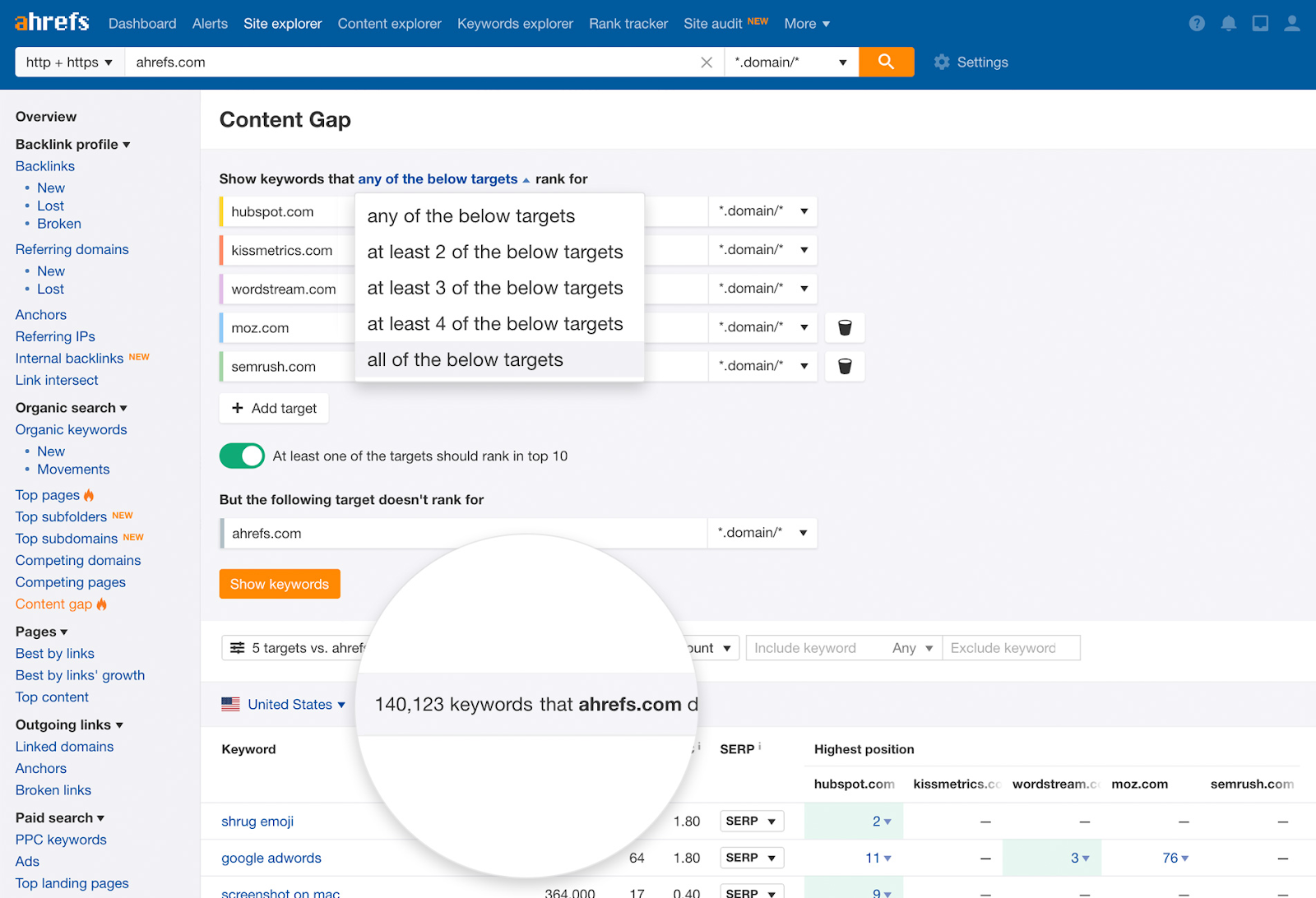
Imagine being able to reverse engineer someone else’s ranking strategy and identify their weaknesses so you can win big? Well, there’s a way and that is through SEO gap analysis.
You are not creating content in a vacuum after all.
In addition to keyword research and identifying potential high-traffic keywords to target, you also need to be looking at what the internet has to offer and how your competitors stand to find better keywords and content opportunities.
SEOs and marketers have a toolbox full of strategies to help you identify these gaps, but among the two most popular tactics are content gap analysis and keyword gap analysis.
Sounds similar? Don’t worry, we will guide you through the differences in these two approaches and how you can use them to inform your keyword strategy.
Now let’s start with a quick definition and how they work.
What is Content Gap Analysis?

A content gap analysis is a great way to start your search campaign. It analyzes your existing content and allows you to discover potential content pieces and topics that your readers want, but are missing from your site.
Usually, this is done through finding the keywords your competitors are ranking for but you don’t. The idea is simple and that is to discover and fill in the content gap between you and your competitors.
Besides, if your competitors are targeting these keywords, chances are prospects searching for these keywords could be looking for your business too.
What is Keyword Gap Analysis?

Keyword gap analysis, otherwise known as competitive keyword analysis, is a more thorough approach to analyzing the gap between you and your competitor’s ranking keywords.
Instead of only identifying the keywords that you are not ranking for, the process is more centered on bridging the gap and discovering valuable keyword opportunities that you should target for better search visibility and traffic.
Like content gap analysis, it adopts competitors’ keywords that you are not ranking for but extends to common keywords as well.
It takes into consideration your ranking keywords and how it is performing compared to your competition. Through this practice, you are not only looking for search terms you have yet to target or rank but identifying and understanding how you can better optimize your content.
Moreover, the process identifies questions that users may be asking related to your keyword that will help you uncover new content insights.
Content vs Keyword Gap Analysis
To better illustrate the difference between content gap vs keyword gap analysis, think of content gap as part of keyword gap analysis framework.
While both gap analysis compares your existing keyword strategy to your competitors, content gap focuses on keywords you do not rank while keyword gap analysis focuses on wider areas of opportunities to improve your overall search visibility.
How Does Content Gap Analysis Work?
Though content gap analysis was previously done manually, Ahrefs has introduced a Content Gap tool that automated the whole process.
It allows you to compare your ranking keywords with a bunch of competitors at the same time, and you can filter the keyword results into:
- Keywords that any of your competitors are ranking for
- Keywords that a certain number of your competitors are ranking for
- Keywords that all of your competitors are ranking for

This data can help you get insight into understanding each website’s business model, keyword strategy, competition, as well as what is missing from your target keyword list.
Using this filter, you can easily access all the keywords that your competitors rank for in search results, but you do not.
The only caveat to this is that you might be trying to rank for search terms that aren’t related to your products or target audience, so think twice before you target them.
In addition to the domain level, you can also conduct content gap analysis on a page level using Ahrefs Content Explorer which allows you to uncover all the ranking keywords for a page.
Compare this with your content on the topic to see if there are any missing keywords you can include to better optimize your content.
How Does Keyword Gap Analysis Work?

With keyword gap analysis, you are looking to discover better ranking opportunities, and that can be for new keywords or improving on existing rankings.
When conducting your competitive keyword analysis, you are looking to find valuable and relevant keyword opportunities. Keep in mind to assess their ranking difficulty and identify only keywords that can truly bring value to your business.
Now we know it’s not always easy to rank high for the keywords you are competing with, but some keywords that might be more worth the effort than others.
Here are four categories of keywords that you should focus on to better close the gap between you and your competitors:
1. Keywords that you rank for, but your competitors don’t

There are thousands of websites out there trying to steal your rankings, and of course, you want to avoid that at all costs.
That’s why knowing what your top ranking keywords are and consistently tracking their SERP results is fundamental to prevent your competitors from stealing them. You can use rank tracking tools like BiQ Rank Tracker to be on alert.
Besides, when you know which are your top-ranking keywords, you can also play on your home turf leverage to further optimize and easily rank for related keywords.
Let’s say you are ranking for a long-tail keyword like “what is the best shaving cream for men”. In this scenario, you can create skyscraper content to target related short tail keywords like “shaving cream for men” or “men’s shaving lotion”.
Just make sure to interlink your content to strengthen your authority on the subject.
On the other hand, if you are already ranking for a short tail keyword, you might find that the page is simultaneously holding various top positions for similar ranking keywords.
This is proven by an Ahrefs study noting that the average top-ranking page in the top 10 search results is ranking for almost 1,000 related search terms.
But still, some might be ranked lower than others.
In that case, creating an in-depth content that directly answers the keyword’s search intent would land you on a better ranking, especially given your authority in the subject.
2. Keywords that your competitors rank for, but you don’t

If your competitors are targeting these keywords to rank, it’s most likely highly relevant to your business too.
Find the keywords with decent or high volume and steal them to employ in your content. Most importantly, understand the strategy that your competitors are using and replicate them to get high traffic.
Still, it’s unlikely that all the keywords are relevant to your business so make sure to sift through them to find the only relevant opportunities.

There are three things to consider when targeting these keywords:
- Business value – Is this search term made by potential customer prospects? How likely will these searchers buy what you sell?
- Search volume – What is the average number of monthly searches for the keyword? Does the search volume have high organic traffic potential that justifies content creation?
- Buyer journey – What is the search intent behind the keyword? What stage of the buyer’s journey are they at?
Answering these questions will help you understand if the keyword will fit into your content strategy and how.
3. Keywords that both you and your competitors rank for

Where you rank on search matters. If you and your competitors are both ranking for the same keywords, you must rank closer if not in the #1 position.
Backlinko studies have pointed out that the #1 ranking result is likely to be driving 10X more clicks and traffic compared to the #10 ranking content. So make sure to prioritize reoptimization in your content strategy especially for keywords on the first page.
You can identify these keywords by using BiQ’s Rank Intelligence to uncover your keywords that are ranking on the 1st page and further improve them.

Just input your domain URL and set the filter to show only those results positioning from #2 to #10. Arrange the keyword list according to potential traffic volume and kickstart your content re-optimization from there.
At the same time, you can also check in on your #1 position rankings and strategize methods to stay ahead of your competition. Always make sure your content is updated and relevant to avoid competitors from stealing your spot.
One SEO tool that can help you improve your content relevance and performance is BiQ’s Content Intelligence.
Using its Word Vector mode, you can optimize based on the suggestions to further improve your contextual relevance as compared to the top 10 ranking search results.
4. Ranking keywords that you and most of your competitors don’t have
Everyone wants to rank for competitive keywords, but that’s impossible in the short term, especially when your website is just starting out.
When analyzing your competitors’ keyword list, you also want to find low competition keywords that are easy to rank for.
These searches are often very specific, and you want to find a keyword that is in the sweet spot of being not popular enough to be overly crowded with competitors, but still common enough to send you website traffic.
Sometimes, you may uncover hidden keyword gems or new trending keywords that your competitors have yet to realize.
Just take the search term “growth hacking” for example. Although it was first coined by Dropbox marketer Sean Ellis back in 2013, the term only started gaining popularity a few years later and is seeing its peak now.

Now, the keyword has almost a thousand related keywords and over 669K total monthly search volume.

Key Takeaway: Start Your Gap Analysis
As the web gets more competitive and many are evolving in using keyword research and great content to benefit their business, you need to evaluate what your competitors are doing.
Doing a content and keyword gap analysis will help you see how your site stands comparatively and discover untapped keywords and ranking opportunities.
Performing a keyword gap analysis especially can help you pinpoint ways you can further expand your existing content and bridge the keyword gap based on your strengths and weaknesses.
So take action now and once you identify your gap keywords, strategize with creativity to close the gap or start a business from an angle your competitors never thought of.
If you want to know more about the amazing strategies and steps in conquering your competitor keywords, head straight to our Ultimate Keyword Gap Analysis Strategies blog post.

